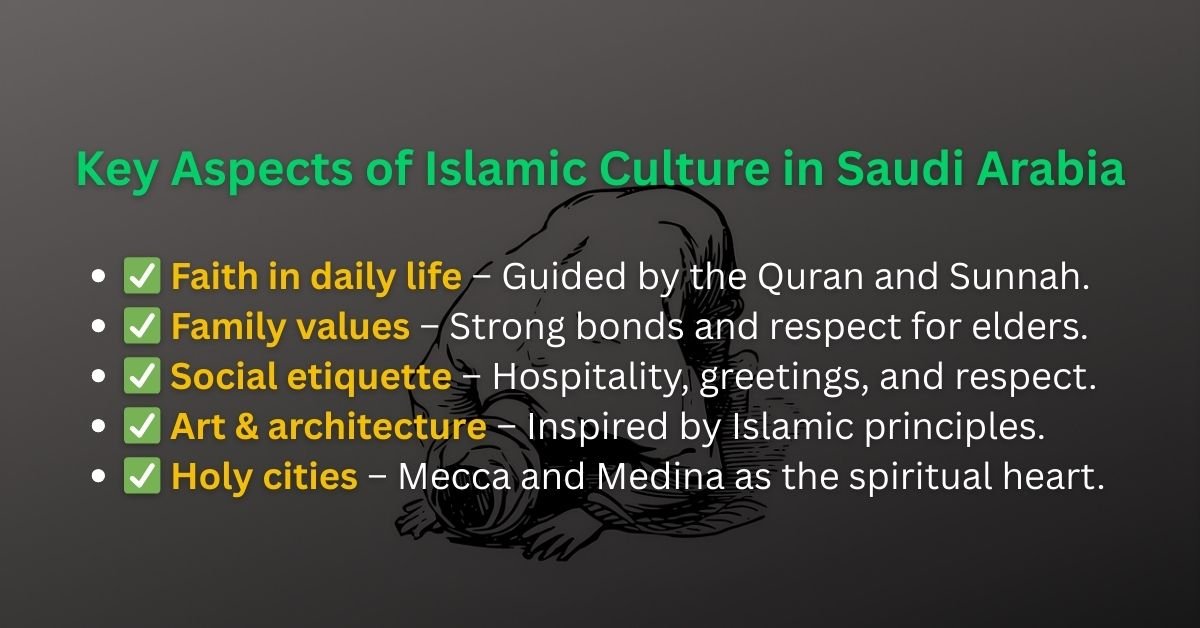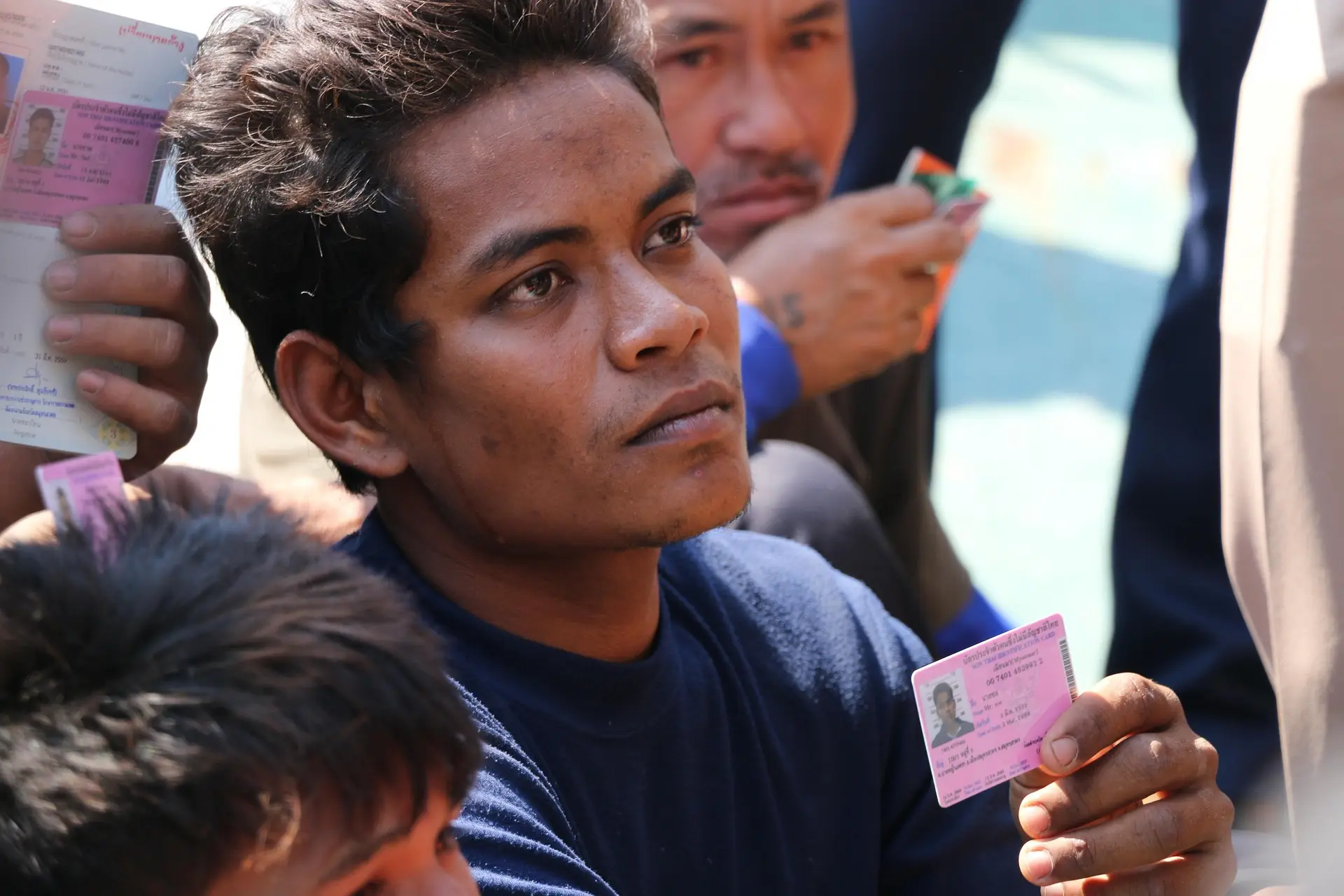✍️ Written by Waqas | ⏱️ Read Time: 12 minutes | 📅 Last Updated: Aug 22, 2025
Islamic Culture in Saudi Arabia
Islamic culture in Saudi Arabia is deeply rooted in faith and tradition, guiding daily life, social customs, and family values. As the birthplace of Islam and home to the holy cities of Mecca and Medina, the Kingdom reflects its religious heritage while embracing modern changes.
Key Aspects of Islamic Culture in Saudi Arabia
- ✅ Faith in daily life – Guided by the Quran and Sunnah.
- ✅ Family values – Strong bonds and respect for elders.
- ✅ Social etiquette – Hospitality, greetings, and respect.
- ✅ Art & architecture – Inspired by Islamic principles.
- ✅ Holy cities – Mecca and Medina as the spiritual heart.
Table of Contents
Introduction
Saudi Arabia is often called the heart of the Islamic world because it is the birthplace of Islam in the 7th century. The religion began in Mecca and Medina, two cities that remain the most sacred for Muslims around the globe. This makes Saudi Arabia not only a spiritual center but also a country where Islamic culture shapes daily life in powerful ways. For those interested in understanding life as an expat in the Kingdom, you can read more about it here.
The teachings of Islam influence almost every part of society in the Kingdom. From family traditions and social customs to festivals and religious practices, faith is closely tied to culture. At the same time, Bedouin traditions of hospitality, honor, and community have blended with Islamic values to create a unique way of life.
In today’s world, Saudi society is also changing. Modernization and globalization bring new ideas, technology, and lifestyles, but the foundation of life still remains deeply rooted in Islamic values. This balance of tradition and modernity makes Saudi culture rich, dynamic, and constantly evolving.
In this article, we will explore how Islamic culture in Saudi Arabia developed through history, how it shapes daily life, and how it continues to adapt while staying true to its roots.
Historical Foundations of Islamic Culture
The story of Islamic culture in Saudi Arabia begins long before the rise of Islam. In pre-Islamic Arabia, life was shaped by tribal traditions, a nomadic lifestyle, and strong values of loyalty, honor, and poetry. Poetry in particular was not just art, but a way to preserve history, knowledge, and identity for future generations.
Everything changed in the 7th century with the birth of Islam. The message of the Prophet Muhammad (PBUH) in Mecca and Medina gave people a new spiritual direction based on monotheism, social justice, and community living. These teachings laid the foundations of a society where faith guided daily life, relationships, and governance.
Later in the 18th century, a historic alliance between the Al Saud family and the scholar Muhammad ibn Abd al-Wahhab shaped the country’s future. This partnership spread Wahhabism, a reformist movement that emphasized returning to what was seen as the pure form of Islam. It also connected religion with politics, influencing the laws, traditions, and identity of modern Saudi Arabia.
Because of these deep roots, Islamic culture in the Kingdom is more than religion—it is a complete way of life. From social values to government policies, history has ensured that Islam remains at the center of Saudi identity.
Islamic Culture in Daily Life
In Saudi Arabia, Islamic culture is not just about religion—it is a way of life. The Five Pillars of Islam—Shahada (faith), Salah (prayer), Zakat (charity), Sawm (fasting), and Hajj (pilgrimage)—form the foundation of everyday routines, values, and traditions.
Daily prayers, or Salah, mark the rhythm of life. The call to prayer can be heard across cities and villages, reminding people to pause and reconnect with their faith. This practice creates a strong sense of community and discipline.
The spirit of giving through Zakat shows how faith encourages social responsibility. Charity is seen not only as a duty but also as a way to support the poor and strengthen community bonds.
During the holy month of Ramadan, fasting or Sawm brings families and friends together. The evening meal, Iftar, becomes a moment of hospitality, unity, and reflection.
For many, the dream of performing Hajj in Mecca is the ultimate spiritual goal. Even for those who cannot travel, the pilgrimage holds a special meaning, inspiring devotion and reminding people of their connection to the wider Muslim world.
Beyond these religious duties, Islamic traditions also shape family life, respect for elders, and the famous Saudi hospitality. Together, these values ensure that faith is not limited to worship but influences the way people interact, share, and live every day.
Artistic Expressions in Islamic Culture
Islamic culture has always valued art as a way to express faith and preserve tradition. In Saudi Arabia, this influence is most visible in architecture, calligraphy, and traditional crafts, which blend beauty with spirituality.
The most striking example is Islamic architecture. Mosques such as the Grand Mosque in Mecca and the Prophet’s Mosque in Medina are not only places of worship but also masterpieces of design. Their domes, arches, and geometric patterns reflect the harmony and balance at the heart of Islamic culture.
Another powerful form of art is Arabic calligraphy. The writing of Quranic verses in flowing, elegant script has long been seen as a sacred art. In Saudi Arabia, calligraphy is found in mosques, homes, and even modern artwork, showing how tradition continues to inspire creativity.
Music and folk traditions also carry the spirit of Islamic culture. Traditional songs, poetry, and dances celebrate heritage, while crafts like pottery, weaving, and metalwork keep alive the skills passed down through generations. Today, Saudi artists are blending these traditions with modern styles, creating a cultural bridge between the past and present.
These artistic expressions highlight how Islamic culture in Saudi Arabia is not only about religion—it is also about creativity, identity, and keeping history alive through beauty and art.
The Significance of Mecca and Medina in Islamic Culture
The two holy cities, Mecca and Medina, hold a special place in Islamic culture and are central to the faith of Muslims worldwide.
Mecca is the birthplace of the Prophet Muhammad (PBUH) and home to the Kaaba, the most sacred site in Islam. Every day, Muslims across the globe face the Kaaba during their prayers, showing its importance in uniting the Muslim community. Each year, millions of pilgrims travel to Mecca to perform the Hajj pilgrimage, one of the Five Pillars of Islam, making it one of the largest spiritual gatherings in the world.
Medina, the second holiest city in Islam, is where the Prophet Muhammad established the first Muslim community. It is also home to the Prophet’s Mosque, which houses his tomb. For Muslims, visiting Medina is a chance to connect with the Prophet’s life, teachings, and legacy.
For Saudi Arabia, being the custodian of Mecca and Medina is a source of pride and responsibility. This role strengthens the country’s identity as the guardian of Islamic culture and heritage, while also reminding Muslims everywhere of their shared spiritual roots.
The deep emotional and spiritual connection to these holy cities shows how Islamic culture in Saudi Arabia is not only about traditions but also about faith that unites millions of people across the world.
Islamic Culture and Modern Transformations Under Vision 2030
Saudi Arabia is experiencing big changes through its Vision 2030 plan, which aims to modernize the country while protecting its deep-rooted Islamic culture.
One of the main goals of Vision 2030 is to diversify the economy and reduce reliance on oil. This shift has opened doors to tourism, arts, and entertainment, areas that were limited in the past. New cultural festivals, concerts, and art exhibitions show how the country is embracing global influences while still respecting Islamic values.
Tourism has become a key focus. The government now encourages visitors from around the world to explore Saudi Arabia’s holy cities, historic landmarks, and cultural heritage. The introduction of an electronic visa system has made it easier for international travelers to visit, bringing more global attention to the Kingdom’s Islamic identity.
At the same time, massive projects like NEOM, a futuristic city, reflect how Saudi Arabia is looking to the future. These modern developments show that the country can adopt new technologies and lifestyles without losing its connection to Islamic culture and traditions.
Vision 2030 highlights a careful balance: opening up to the world while making sure Islamic culture in Saudi Arabia remains central. This balance ensures that modernization does not erase history but instead creates a bridge between tradition and progress.
Challenges and Opportunities in Preserving Islamic Culture
As Saudi Arabia modernizes, it faces both challenges and opportunities in keeping its Islamic culture strong.
One of the main challenges is the influence of globalization and Western culture. With social media, technology, and international travel, younger generations are often drawn to new lifestyles that may differ from traditional Islamic values. This creates a generation gap, where elders focus on preserving traditions while the youth push for modern change.
Another challenge is the speed of modernization itself. As new cities, entertainment hubs, and global trends arrive, some worry that Islamic culture and heritage might be overshadowed by rapid development.
But these challenges also bring opportunities. Saudi Arabia is now investing in cultural festivals, art exhibitions, and educational programs to showcase its traditions while allowing modern expression. This approach helps keep Islamic identity alive while making it relevant to younger generations.
By promoting dialogue between generations and encouraging pride in heritage, Saudi Arabia can create a society that values both tradition and progress. In this way, the Kingdom has the chance to become a global example of how Islamic culture can thrive in a modern world.
Culinary Traditions and Islamic Culture
Food is an important part of Islamic culture in Saudi Arabia, reflecting both faith and tradition. Meals are more than just eating—they are a way of showing hospitality, generosity, and community spirit.
One of the most famous dishes is Kabsa, a spiced rice meal often cooked with lamb or chicken. It is commonly served at family gatherings and celebrations, symbolizing unity and tradition. During the holy month of Ramadan, food takes on even greater meaning. Muslims break their fast with dates and water, followed by a larger meal called Iftar, which brings families and friends together.
Other traditional foods like Harees, Sambusas, and Fattoush are also tied to religious and cultural practices. These dishes are not just tasty—they carry memories, values, and connections to heritage.
Islamic dietary laws, especially the requirement of Halal food, guide how meals are prepared and served. This ensures purity, cleanliness, and respect for faith in daily life. From simple snacks to festive meals, food in Saudi Arabia reflects the balance of Islamic values and cultural traditions.
In many ways, the dining table becomes a place where Islamic culture is lived, shared, and celebrated, making culinary traditions a vital part of Saudi identity.
Conclusion: The Tapestry of Islamic Culture in Saudi Arabia
Islamic culture in Saudi Arabia is a living tapestry, woven from faith, history, and tradition. From the daily practices of Muslims, such as prayers, fasting, and charity, to the artistry of calligraphy, architecture, and poetry, Islam shapes the identity of the nation in profound ways.
The Kingdom’s holy cities, Mecca and Medina, continue to connect people across the globe to a shared spiritual heritage. At the same time, modernization and initiatives like Vision 2030 show that Saudi Arabia can embrace progress while preserving its Islamic values.
Even everyday elements, such as food, hospitality, and family traditions, reflect how deeply Islamic culture influences life in the Kingdom. Challenges like globalization and generational change exist, but they also create opportunities to blend tradition with innovation.
In essence, the rich Islamic culture of Saudi Arabia is not just about religion—it is a way of life, a source of identity, and a bridge between the past and the future. By appreciating this unique cultural fabric, we gain insight into a society that honors its roots while looking forward with confidence and creativity.
To get a quick visual overview of Saudi Arabia’s history and culture, watch this informative video:
How does Bedouin heritage influence modern Saudi Islamic culture?
Beyond hospitality, Bedouin heritage shapes tribal loyalty, oral traditions, resilience, and interpersonal harmony, influencing how Saudis live Islamic culture today.
How are traditional gender roles evolving in Saudi families under Vision 2030?
While women have new legal freedoms under Vision 2030, family expectations and tradition still influence daily roles, making changes gradual and generational.
How do regional dialects and customs reflect Islamic culture in Saudi Arabia?
Regional customs in Saudi Arabia show Islamic culture in diverse ways—Hijazi areas are more cosmopolitan, Najd is conservative, and the Eastern Province has unique religious practices, all reflected in food, music, attire, and etiquette.
How is the role of mosques changing with digitalization in Saudi Arabia?
Mosques remain central for worship, but with digitalization, many now stream sermons, share lessons online, and serve as community hubs blending tradition with modern tools.


